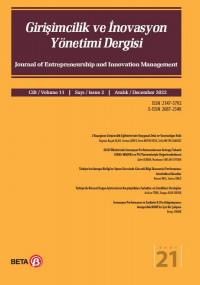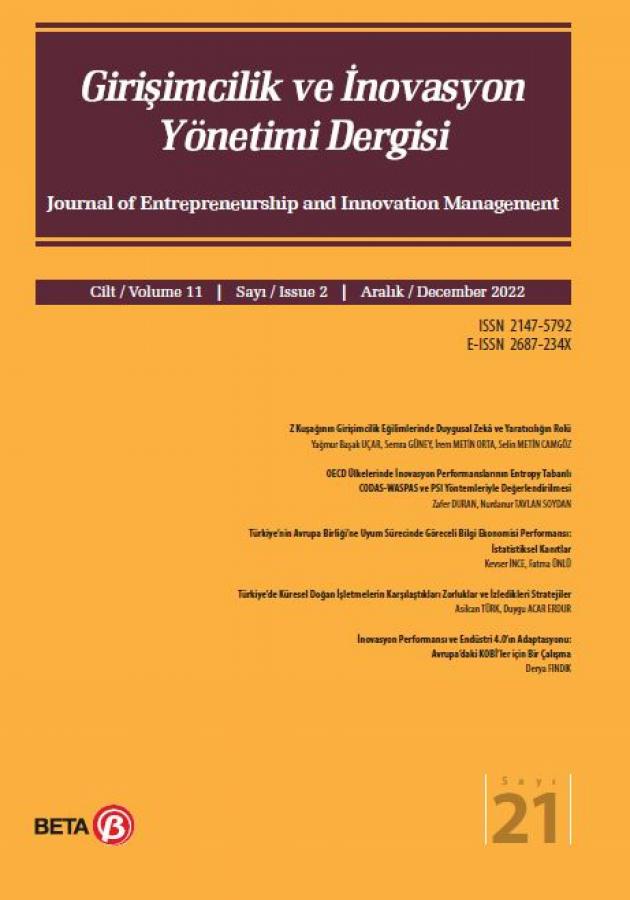12 (2), 2023
Gizem Fatma ÇETİN EKMEKÇİOĞLU & Aykut GÖKSEL
Türkiye Fintek Startup Ecosystem: A Narrative Analysis
Objective: The aim of this research is to analyse the interviews of startup founders in the Turkish Fintek Ecosystem and
determine the critical success factors for Fintek startups.
Method: Narrative analysis, one of the qualitative research methods, was conducted to determine the critical success
factors.
Findings: According to the results of the narrative analysis, the critical success factors affecting Fintek startups at the
individual level are the startup idea, the experience of the founder / core team in the sector, the previous startup experiences of the founding team, technology and business skills, R&D experience and the importance given to R&D, the
entrepreneur’s experience in management, leadership and the diversity of the experiences of the startup core team. At
the organisational level, team spirit, organisational culture and organisational structure, organisational size, lean organisation, quality and results of partners/institutions and business relations, global nature, human resources and human
capital, investor capital and investor relations. At the environmental level, the role of the state and the dynamism of the
environment variables were found to affect fintech startup success.
Conclusion and Suggestions: It is necessary to establish the diversity of the founding team to support the technological, financial and legal infrastructure, to develop the necessary qualifications for sustainability, to give importance
to continuous innovation, especially to identify an important problem or deficiency of the sector starting from the idea
development stage and to develop a business model with an unrivalled solution.
Original Value: In this study, fintek startups are examined and the variables that are critical for their success are analysed and revealed for the first time using narrative analysis method. The analysis, which is based on the views of the
representatives of the sector, develops a different flow perspective to reveal the current situation.
Keywords: Entrepreneurship Ecosystem, Startup, Fintek Ecosystem, Qualitative Analysis, Narrative Analysis
DOI : 10.15659/jeim.12.2.001 [PDF]
Ahmet ÇUBUKCU, Kazım KARABOĞA & Halil İbrahim AYAZ
Measuring Innovation Culture: Validation Study of the Innovation Quotient Model and Research on a Defense Industry Firm in Turkey
Purpose: While the innovation management literature has progressed over a wide range, culture, one of its most essential and initial parts, has been a relatively less focused area. Although there are some studies on innovation culture, there is not much consensus on how to measure innovation culture. This study has attempted to reveal what innovation culture components should be and how regional results and innovation awareness affect culture. Methodology: This study assesses the construct validity and reliability of the Innovation Quotient instrument, which measures innovation culture in firms across the broad spectrum. The instrument’s dimensions were examined, and we attempted to validate the instrument. We conducted the study on 1432 employees of a Turkish defense industry firm. The model’s results were evaluated, and the model’s new structure was presented. Findings: We reached three main points: 1. The cultural structure and regional innovation ecosystem affect the measurement of innovation culture 2. A firm’s lack of a corporate innovation system prevents some questions about innovation culture from being understood 3. To measure innovation culture in firms, cultural indicators such as the behavior of managers, the working climate, and values should be considered initially rather than the input, output, or performance indicators of innovation. Practical implications: The findings of our study indicate some implications for managers regarding the importance of innovation culture. These validated study outputs offer managers a way and attitude to initiate innovation. It also analyzes the current situation and supports managers in overcoming their shortcomings. It shows the areas that need to be focused on to make their organizational structures more agile and innovative. Originality: Various measures and dimensions of an innovation culture have emerged in recent decades. However, there is inconsistency regarding the number and content of the dimensions across various measures of culture. However, the validity and reliability of most of these measurements have not been tested. This study fills the literature gap by analyzing a frequently used scale to reveal what an innovation culture scale should consist of.
Keywords: Corporate Innovation, Culture, Innovation, Innovation Culture, Organizational Culture
DOI : 10.15659/jeim.12.2.002 [PDF]
Zehra Binnur AVUNDUK
Reflections of Industry 4.0 and Innovation Interaction in International Literature: A Bibliometric Analysis
Purpose: Today, with the dizzying development of technology, there is an age of industry 4.0 in production management. Industry 4.0, on the other hand, is developing rapidly with the daily discovery and implementation of different innovations. For this reason, examining the interaction between industry 4.0 and innovation at an international level is significant. This study aims to explore the interaction between Industry 4.0 and innovation and to provide information on essential topics and concepts with the bibliometric analysis method, which allows a comprehensive quantitative review of the literature. Methodology: The bibliometric analysis technique used as a research method was applied to the article data obtained from the Web of Science Core Collection database with the VOSviewer program. A mapping of the existing literature based on bibliometric parameters such as year, country, author, and source was made. The articles within the scope of the research were clustered based on keyword co-occurrence and bibliometric coupling analysis. Findings: As a result of the study, eight clusters based on keyword co-occurrence were identified. Clusters representing industry 4.0 and innovation themes were examined and named as open innovation, sustainability and circular economy, digitalization and technology, managerial & organizational issues, industry 4.0, knowledge management, risk and performance, and development. Practical Implications/Originality: How the concept of Industry 4.0 and innovation, which are inseparable from each other are approached in the literature, which themes come to the fore, and which research gaps exist will provide researchers and practitioners with a foresight for future studies. Furthermore, a comprehensive review of this subject provides up-to-date information to academics and practitioners about research trends. Another theoretical contribution of the study is revealing the different types of innovation addressed by Industry 4.0 in the international literature, drawing attention to innovation types not commonly encountered in national literature. As a practical implication derived from the research, Industry 4.0 has become necessary for companies with smart production systems to change their business models while innovating to cope with customers’ changing demands while maintaining the production of high-quality products and services in the smart factory and switching to a flexible value chain. Particularly, rapidly aligning the production processes in SMEs with Industry 4.0 technology is crucial for Türkiye to achieve global competitive advantage.
Keywords: Innovation, technology, industry 4.0, bibliometric analysis, Web of Science Core Collection
DOI : 10.15659/jeim.12.2.003 [PDF]
Yasin AKKUŞ
Developing the Scale of Social Barriers in Entrepreneurship and Its Relationship with Locus of Control, Entrepreneurial Intention
Purpose: In this study, it was aimed to develop the scale of social barriers in entrepreneurship and to examine the relationship of this scale with locus of control and entrepreneurial intention. Method: Mixed method was used in the study. The exploratory sequential design was adopted from the mixed method designs. In the qualitative part of the study, two focus group interviews (12 people in total) were conducted, and in the quantitative part, data were collected from 631 university students by questionnaire method. Analyzes were carried out using the MaxQDA program in the qualitative method and the Smart PLS program in the quantitative method. Findings: In the study, the Social Barriers in Entrepreneurship Scale, which consists of four statements with sufficient reliability and validity, was developed. In addition, a positive, linear and significant relationship was determined between Social Barriers in Entrepreneurship and Locus of Control. In other words, it can be said that entrepreneurial candidates who have social barriers adopt external control-oriented behavior. Again, a negative, linear and significant relationship was found between Social Barriers in Entrepreneurship and Entrepreneurial Intention. Accordingly, as the entrepreneur’s perception of social barriers increases, he refrains from being an entrepreneur. Practical Implications: It is seen that social barriers are an important variable in entrepreneurship and are related to other variables related to entrepreneurship. It is recommended to examine the scale in different dimensions such as friends and family and to investigate its relationship with different variables. Originality: This study; It reveals a scale that is not found in the literature, both in terms of social barriers and entrepreneurship. It is thought that this scale can reveal new findings about the social barriers of entrepreneurs that have not been investigated before.
Keywords: Social Barriers in Entrepreneurship, Locus of Control, Entrepreneurial Intention, Scale Development
DOI : 10.15659/jeim.12.2.004 [PDF]
Esra ŞAKAR, Ayça Yeşim ÇAĞLAYAN & Çiğdem YILMAZ ÖZSOY
Determining Innovation Strategy to Improve Innovation Performance in Landscape Architecture Industry in Turkey
Purpose: This study focuses on the analysis of the innovation strategies that might be applicable by the private sector organizations doing business in the landscape architecture industry to guarantee their survival under competitive conditions for many years and to follow the sector dynamics by keeping up with the everchanging and advancing technologies, and it also analyses the factors having impact on the development of these strategies. Methodology/Approach: This research consists of the stages of communicating the questions (general company information and AHP method) obtained in line with the data obtained as a result of the literature research to the research participant companies and evaluating the results. Findings: When innovation inputs and innovation outputs are compared according to participant responses, it is seen that innovation outputs are more important. R&D and design expenditures are more important than human resources. Exports are more important than intellectual property rights. Practical implications: The study concluded that the optimum strategy for this industry is the aggressive innovation strategy and the goal should be targeting the development of a strategy driven by the innovation outputs. Originality: It is an original research on the innovation strategy of the landscape architecture sector
Keywords: Innovation, Innovation Strategy, Research and Development, Desing Center, Landscape Architecture
DOI : 10.15659/jeim.12.2.005 [PDF]
Cevahir UZKURT
From The Editor
Dear colleagues,
Bringing the each issues on to your screen is both very tiring and exiting period and it requires allot of joint effort from all sides. Now we are so happy to bring our new issues to you and we hope you will enjoy reading our issue. We are thankful for those who supporting us either by sending their research results. Despite receiving number of article, we could only finalize two of them to be ready for the issue. Although the number of the publish article is law, the spent effort is more and quality of the paper is very good. We congratulate all the authors and the reviewers who help us to improve the quality of the papers. Without their support it would not be possible to bring the Journal to this level. In this new issue, we have different well-addressed two research papers about innovation analytics which is introduced the literature recently. The second paper is about how to increase the level of entrepreneurship of countries in GEM reports by using artificial intelligence techniques. We hope this issue will also provide useful information both researchers, professionals as well as it will also provide useful information for policy makers. Finally, I like to remind you that you can access all our past and current issues with no charge. I strongly recommend you to read our publications and I believe this will be helpful for your current research and professional business.
Best Regards
[PDF]


